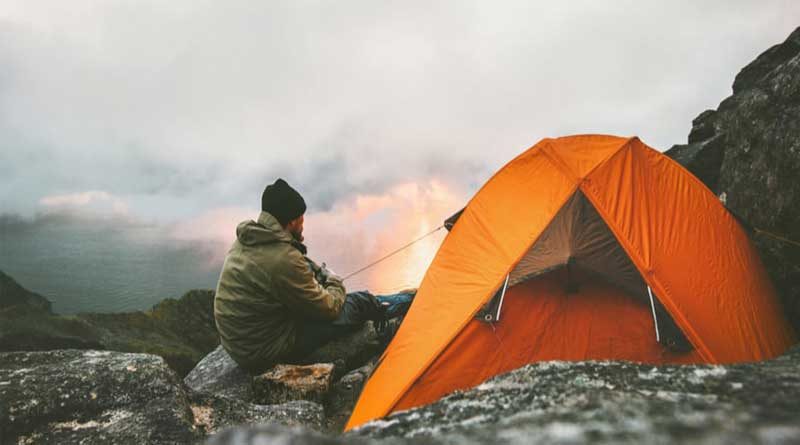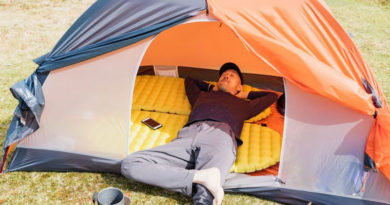Backpacking vs. Camping Tents: A Comparison
The terms “backpacking” and “camping” are often used interchangeably. But both activities are completely different from one another. Not many people are aware of the difference. When it comes to tents, people are confused between backpacking and camping ones. To complicate the matter further, both, backpacking and camping tents look the same. The differences are subtle. Both types of tents are usually referred to as camps and the question about the difference becomes valid.
The primary difference between both types of tents is the weight. Backpacking tents are lighter – around 3 pounds or less and they can be carried easily in a backpack. Camping tents, on the other hand, are heavier and can easily weigh around 10 to 12 pounds.
What is Backpacking?
Backpacking requires you to carry all the essentials with you in a backpack. You get little to no facilities along the way so you must be prepared for everything. Backpackers usually travel to a trail in their vehicles. They leave their vehicles at the trailhead and continue their journey on foot. When they find a suitable spot, they set up camp.
Some trails require you to walk for miles before reaching a suitable spot to spend the night. Backpacking requires you to pack smart. Every ounce of weight counts when it’s tied to your back for miles on foot. That is why backpacking tents are kept lightweight.
What is Camping?
Camping involves going to a national park that has designated camping zones. You usually get there using your car or some other means of transport. The main thing is, you don’t have to walk there. You get off your car or whatever and set up camp.
Camping involves going to a national park that has designated camping zones. You usually get there using your car or some other means of transport. The main thing is, you don’t have to walk there. You get off your car or whatever and set up camp.
Once you set up your camp, you can go around exploring the campsite visiting different scenic spots. You can have access to toilets, a shower, and even a sink in some cases at campsites. You don’t have to walk long distances carrying a heavy backpack with you.
In situations like these, you can bring a heavy tent with you because you won’t be doing a lot of carrying. That is why weight isn’t the priority when it comes to camping tents.
Can you use a Backpacking Tent for Camping?
Yes, you can. Backpacking tents are all-around better tents. If you are into both activities, then a backpacking tent can work for you. But you should avoid using backpacking tents if you are in a small group that is sharing the tents. Backpacking tents are especially good for camping trips that can turn into backpacking trips.
Similarly, you can use camping tents during backpacking in certain cases. It is better to bring camping tents in small group setups where weight is shared by all the members of the group. Camping tents are large and can accommodate a small group easily.
Features to Look for in a Backpacking Tent
If you are looking to buy a backpacking tent, then you should consider the following factors:
Weight
Weight is the most important factor when choosing a backpacking tent. The heavier the tent, the harder it is for you to carry. Most manufacturers list the weight of their tent in its product description.
The confusing part is the minimum trail weight and the packaged weight. But there is nothing to be confused about. Minimum trail weight is the weight of the tent minus its rainfly and other attachments. The packaged weight of the tent includes everything that comes with the tent.
Capacity
A backpacking tent should only be big enough for the number of people that are going to sleep in it. They are usually designed for one to four people. There are no set standards about the dimensions of these tents based on the number of people they are made for.
A single-person tent from one brand may have different dimensions from a single-person tent of another brand. If one-person tents are too tight for you or you are larger than an average-sized person, a two-person tent would be better. Four or three-person tents are better for small group settings where the weight is shared.
Durability
The material of the tent determines how durable it is. Backpacking tents are made of either nylon or Dyneema. Dyneema is very strong, ultra-lightweight, and unsurprisingly, expensive. Nylon is less durable, heavier, and cheap.
The denier rating determines how strong the material used is going to be. Nylon tents can be somewhere from 7D (denier) to above 1000D. Backpacking tents are usually around or under 100D. The denier of the floor of the tent is what you should focus on. Backpacking tents using a thinner material require a tent footprint to protect the floor from being damaged.
Tent footprints are usually sold separately. Some high-end backpacking tents include the footprint with them.
Seasons
Tents are also categorized by the number of seasons they can be used in. There are single-season, three-season, and four-season tents. As the name suggests, single-season tents can only be used for a single season, the summer season. A three-season tent can be used in the spring, summer, and fall seasons. A four-season tent can be used for the whole year.
But don’t let these categorizations fool you. A three-season tent is a better choice for most people. It can also handle the winter season. A four-season tent is heavy and best suited for extreme winter camping with ice and snow. A single-season tent is for those who take ultralight backpacking as a challenge. But if you are not dealing with extreme winter, a three-season tent would be fine for you.
HeadRoom
Manufacturers often include diagrams of how their tents look after setup in the tent’s description. The diagram also mentions the inside height of the tent. The inner height of your tent should be comfortable for you.
Backpacking tents are not high enough that you can stand inside them. But they should have enough headroom inside that you should be able to at least sit up straight.
Features to Look for in a Camping Tent
If you are looking to buy a camping tent, then you should consider the following factors:
Extra Features
Some camping tents offer nothing more than a place to sleep in where they protect you from rain or bugs. Other camping tents come with luxurious features. They can include everything; windows, room dividers, screen porches, etc. The more features there are, the heavier and more expensive the tent is going to be. But since you don’t have to carry the tent on your back for long distances, it doesn’t matter as long as you can afford it.
Camping tents can be high enough for you to stand in them. In short, you can customize a camping tent as much as you like. You can make it your home where you can stay for a few days with your family and enjoy nature.
Capacity
The capacity of camping tents can be huge. Some camping tents can accommodate more than 15 people at a time. If you are planning a camping trip with your family, you would need a large tent. Make sure you have enough floor space in the tent for a group of people that are going to be in the tent.
If you are camping alone, then you can bring a backpacking tent with you. A two-person backpacking tent may still be lighter than a single-person camping tent. You won’t get the luxuries of a camping tent but the tent will be easier to handle alone.
Seasons
Similar to backpacking tents, camping tents are also categorized based on the number of seasons they can be used in. But camping tents are not available as single-season tents. They are available as three or four-season tents.
Four-season tents are for extreme winters. But three-season tents are the sweet spot for most people. Three-season tents can handle most types of weather conditions. However, they won’t handle heavy snow or ice. Unless you plan to camp during heavy snow, a three-season tent would be fine for you.




